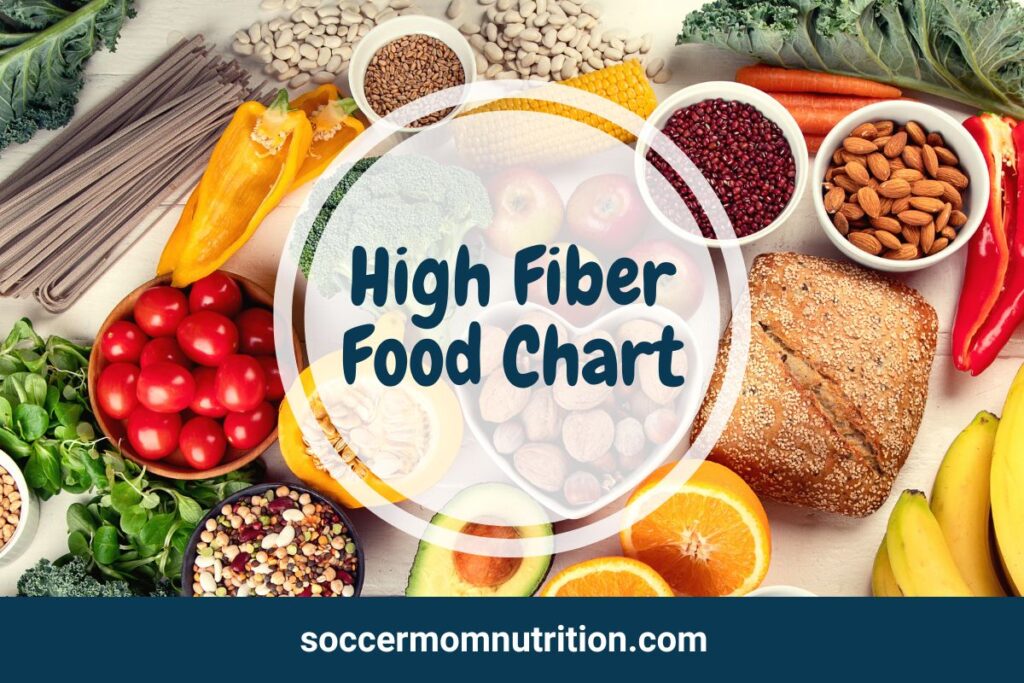High Fiber Food Chart PDF [Printable]
If you’re looking for ideas to add more fiber to your diet, look no further than this high fiber food chart pdf to guide your food choices.
Like many athletes on the go, you’re likely not meeting your recommended fiber intake. When you don’t meet your fiber intake, you’re missing out on key nutrients-vitamins and minerals that help your body function at its best.
Additionally, fiber plays a huge role in gut health which has been shown to have an impact on athletic performance. (1) In fact, your gut microbiome breaks down fiber creating powerful anti-inflammatory effects. (2)
Print out this high fiber food chart pdf or save on your phone for you next trip to the grocery store.

What is fiber
Fiber is a complex carbohydrate found in plants including fruits, vegetables, legumes and grains. However, people cannot digest or absorb into their blood streams for energy, but your microbiome helps to break down fiber.
Fiber is found in plant based foods in both soluble (dissolves in water) or insoluble (doesn’t dissolve in water). Plants tend to have both insoluble and soluble fibers in varying amounts.
Therefore, you should eat a wide variety of high fiber foods in order to get the most benefits.
How much fiber should an athlete eat
The amount of fiber an athlete should eat is based on the the US Dietary Guidelines for Americans. That recommendation is about 14 grams per 1000 calories. (3)
However athletes and the general population only eat about 15 grams per day, about half of the recommended amounts of fiber. (4)
General recommendations for daily fiber intake:
| Age (years) | Fiber Recommendations (grams/day) | |
|---|---|---|
| Men | Women | |
| 4-8 | 25 g | 25 g |
| 9-13 | 31 g | 26 g |
| 14-18 | 38 g | 26 g |
| 19-30 | 38 g | 25 g |
| 31-50 | 38 g | 25 g |
| 51-70 | 21 g | 30 g |
What are the top 20 highest fiber foods
The top 20 highest fiber foods include legumes, beans, berries, grains and vegetables. Check out this list below with the fiber content and serving size (for more ideas check out the high fiber food chart pdf):
- Navy beans (cooked) – 1 cup: 19.1 grams
- Split peas (cooked) – 1 cup: 16.3 grams
- Lentils (cooked) – 1 cup: 15.6 grams
- Black beans (cooked) – 1 cup: 15 grams
- Lima beans (cooked) – 1 cup: 13.2 grams
- Artichoke (cooked) – 1 medium: 10.3 grams
- Green peas (cooked) – 1 cup: 8.8 grams
- Quinoa (cooked) – 1 cup: 8.1 grams
- Raspberries – 1 cup: 8 grams
- Blackberries – 1 cup: 7.6 grams
- Avocado – 1 medium: 6.7 grams
- Chia seeds – 1 ounce: 5.5 grams
- Almonds – 1 ounce: 3.5 grams
- Flaxseed – 1 ounce: 3 grams
- Pear – 1 medium: 5.5 grams
- Apple (with skin) – 1 medium: 4.4 grams
- Sweet potato (with skin) – 1 medium: 4 grams
- Brussels sprouts (cooked) – 1 cup: 4 grams
- Oatmeal (cooked) – 1 cup: 4 grams
- Broccoli (cooked) – 1 cup: 3.7 grams
- Carrots (cooked) – 1 cup: 3.6 grams
- Banana – 1 medium: 3.1 grams
- Orange – 1 medium: 3.1 grams
- Strawberries – 1 cup: 3 grams
- Kiwi – 1 medium: 2.3 grams

High fiber food chart pdf-beans and legumes
| Food | Serving Size | Fiber (grams) |
|---|---|---|
| Navy beans | 1 cup | 19.1 |
| Split peas | 1 cup | 16.3 |
| Lentils | 1 cup | 15.6 |
| Black beans | 1 cup | 15.0 |
| Lima beans | 1 cup | 13.2 |
| Chickpeas (garbanzo beans) | 1 cup | 12.5 |
| Kidney beans | 1 cup | 11.6 |
High fiber food chart pdf-whole grains and cereals
| Food | Serving Size | Fiber (grams) |
|---|---|---|
| Bran Flakes | 1 cup | 7.6 |
| Oat bran | 1 cup cooked | 6.0 |
| Quinoa | 1 cup cooked | 5.2 |
| Oatmeal (rolled oats) | 1 cup cooked | 4.0 |
| Brown rice | 1 cup cooked | 3.5 |
| Wild rice | 1 cup cooked | 3.0 |
| Whole wheat spaghetti | 1 cup cooked | 2.9 |
| Pearled barley | 1 cup cooked | 2.3 |
| Buckwheat | 1 cup cooked | 1.6 |
High fiber food chart pdf-fruits
| Food | Serving Size | Fiber (grams) |
|---|---|---|
| Avocado | 1 medium | 13.5 |
| Raspberries | 1 cup | 8.0 |
| Blackberries | 1 cup | 7.6 |
| Pear | 1 medium | 5.5 |
| Apple (with skin) | 1 medium | 4.4 |
| Banana | 1 medium | 3.1 |
| Orange | 1 medium | 3.1 |
| Strawberries | 1 cup | 3.0 |
| Kiwi | 1 medium | 2.3 |
High fiber food chart pdf-vegetables
| Food | Serving Size | Fiber (grams) |
|---|---|---|
| Artichoke | 1 medium | 10.3 |
| Peas | 1 cup | 8.8 |
| Broccoli | 1 cup | 5.1 |
| Brussels sprouts | 1 cup | 4.1 |
| Carrots | 1 cup | 3.6 |
| Sweet potato | 1 medium | 4 |
| Spinach | 1 cup | 4 |
| Green beans | 1 cup | 3.4 |
| Kale | 1 cup | 2.6 |
| Beet greens | 1 cup | 2.5 |
High fiber food chart pdf-nuts and seeds
| Food | Serving Size | Fiber (grams) |
|---|---|---|
| Chia seeds | 1 oz. | 9.8 |
| Flaxseeds | 1 oz. | 8.2 |
| Almonds | 1/4 cup | 4.2 |
| Pistachios | 1/4 cup | 3.0 |
| Sunflower seeds | 1/4 cup | 3.0 |
| Pecans | 1/4 cup | 2.7 |
| Hazelnuts | 1/4 cup | 2.7 |
| Pumpkin seeds | 1/4 cup | 2.9 |
| Sesame seeds | 1 oz. | 1.4 |

What does 25 grams of fiber a day look like
Generally, 25 grams of fiber a day looks like multiple servings of high fiber foods: 1-2 fruits, 3 vegetables, 1 legume and 2 or more whole grains.
Here are a couple sample menu ideas to get at least 25 grams of fiber each day.
**These are just examples of how to incorporate fiber into meals, but may not meet an athlete’s need for protein and carbohydrate.**
Breakfast:
- 1 cup of cooked oatmeal
- 1/2 banana
- 1 tablespoon of chia seeds
Morning snack:
- 1 small apple (3 grams of fiber)
- 1 ounce of almonds
Lunch:
- 2 cups of mixed greens salad with carrots, cucumber, and tomato
- 1/2 cup of black beans
- 1/2 cup of brown rice
Afternoon snack:
- 1 medium pear
Dinner:
- 4 ounces of baked salmon
- 1 cup of roasted Brussels sprouts
- 1/2 medium sweet potato with skin
Breakfast:
- 1 medium-sized whole wheat bagel
- 1 tablespoon of almond butter
- 1/2 medium apple
Morning snack:
- 1 small orange
- 1 small handful of mixed nuts
Lunch:
- 1 cup roasted veggies peppers, and tomatoes (4 grams of fiber)
- 3 Tbsp hummus
- 1 whole wheat tortilla
Afternoon snack:
- 1 cup of berries
- 1 cup of low fat greek yogurt
Dinner:
- 4 ounces of grilled chicken breast
- 1 cup of steamed broccoli
- 1/2 cup of quinoa
What is the best way to get fiber?
The best way to get fiber is by eating a wide variety of high fiber foods. You can add a fiber rich food to every meal and snack. Start increasing fiber gradually since fiber can cause gas and bloating.
You’ll also want to drink additional water or fluids.
Some suggestions for the best way to get fiber:
- Start your day with a high fiber breakfast cereal or hot whole grain oatmeal
- Blend your favorite fruits and veggies into a high fiber smoothie
- Top your whole grain pancakes or waffles with fresh berries
- Sprinkle low fat greek yogurt with granola, chia seeds and berries
- Swap whole grain and whole wheat pasta, breads, tortillas and crackers
- Add extra veggies on your sandwich or salads
- Use nuts and seeds as additional toppings on salads
- Swap brown rice, quinoa or farro for white rice
- Boost your soup’s fiber with added beans, legumes or whole grains
- Choose fruits for dessert
Final thoughts
Fiber is a key nutrient for athletes. You can use this post and printable pdf to guide your food choices and to help you incorporate more fiber in your diet.
Check out our other posts on how to add more whole grains to your diet.
Stephanie Magill, MS, RD, CD, FAND has over 22 years of experience in public health and nutrition. As a performance registered dietitian nutritionist, Stephanie specializes in sports nutrition and provides simple and actionable information so that athletes can be well fueled for high performance on and off the field. Stephanie has a Master’s Degree in Nutrition and is a Fellow of the Academy of Nutrition and Dietetics.

